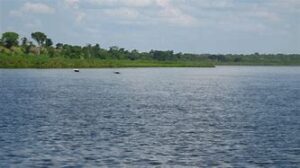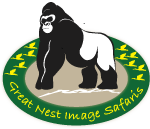Lake Kyoga | Uganda’s shallow Lake
Lake Kyoga | Uganda’s shallow Lake : is a polymictic basin located in the North of Lake Victoria in central Uganda. It is formed by the Victoria Nile in its middle course with an elevation of 1,033 metres and an area of 1720km2. It is shallow, with swampy, papyrus-reeded shores with masses of papyrus broken loose by strong winds. Besides, the Victoria Nile flows through the lake on its way from Lake Victoria to Lake Albert. In fact, the main inflow from Lake Victoria is regulated by the Nalubale Power Station in Jinja. Although Lake Kyoga is part of the African great lakes system, it is not itself considered a great lake.
Frequently asked questions
 How deep is Lake Kyoga?
How deep is Lake Kyoga?
The lake reaches a depth of about 5.7 metres and the areas that are less than 3 metres deep are completely covered by water lilies. In additotion, much of the swampy shoreline is covered with papyrus and the invasive water hyacinth. The papyrus also forms floating Islands that drift between a number of small permanent Islands. Additionally, extensive wetlands fed by a complex system of streams and rivers surround the lakes.
What process led to the formation of the Lake?
Lake Kyoga was formed when a complex of the earth movement began in the Miocene which eventually resulted into faulting of the Western River. This caused the reversal of the previous East-West drainage. River Kafu which was once flowing westwards began to flow eastwards thus formation of “Lake Kyoga” due to ponding-back of the Kafu river.
Who discovered Lake Kyoga?
An Italian explorer “Carlo Piaggia” born on 4th January 1827 in the town of Badia Cantignano in Lucca and died on 17th January 1882. In Sudan, he discovered Lake Kyoga in 1876 which he named “Lake Capechi”. During his journey, he searched for a river passage between the Nile and the great lakes of East Africa.
Is Lake Kyoga a fresh water lake?
Ooohh yes! Lake Kyoga is a fresh water lake and it also has suds seen as Islands some for-bird habitats and others as fishermen villages.
Is the Lake in a Rift Valley?
The lake is also known as a “Rift Valley Lake” which makes it to be in a Rift Valley. It also has an extension of the Victoria Nile that flows through the lake. Besides, its way from Lake Victoria is controlled by the Nalubale Power Station in the Eastern Jinja.
Extensions of Lake Kyoga
The extensions of Lake Kyoga include; Lake Kwania, Lake Bisina and Lake Opeta. These “finger lakes” are surrounded by the swamp land during rainy seasons. They are all shallow, usually reaching a depth of only eight or nine metres. However, Lake Opeta forms a separate lake during dry seasons.
The three different Environmental zones of the Lake
The Lake Kyoga consists of three different Environmental Zones. These include; the open water, the water less than 3 metres and the swamp mainly papyrus which fringe the shoreline. The lake has a rich biodiversity and these include; Flora and Fauna such as Cypenus Papyrus, Hyppo Grass, Cattail, Water Lily, etc.
Fish species
It has got over 46 different fish species and some of them are endemic. However, the Nile Perch was introduced into this lake in the late 1950s to increase the fish population. The Nile Perch proliferation led almost complete elimination of many domestic fish species. These include; Synodontis Victoria, Engraulicypris Argentus, Barbus Kiogae, Tilapia Esculenta, Tilapia Variabilis. Clarias Mossambicus, Mormyrus Kanumme, Schilbe Mystus and the Haplochromis Macrodon.
Activities carried out on at the Lake
Fishing
The lake boasts with over 46 fish species which makes fishing one of the main activities. This activity is basically done at the designated area. However, your required a fishing permit and make sure to carry your own fishing gear if you want to carry out this activity.
Cultivation
You will get a chance to see how the people in this area grow and improve the growth of different crops. Here, you will also be given a chance to take part in this activity. The activity is carried out to improve soil physical conditions, limit weed growth, improve water percolation, etc.
Livestock farming
Generally, people around the lake raise animals for use or even pleasure. These animals are commonly farmed for their meat, hides, wool as well as milk. While on your trip, you will be able to engage in this activity and witness how fun it is to rare cattle.
Birding
This place is also endowed with a number of bird species that can be sighted on the shores including aquatic, migratory and residential birds. These include; king fishers, African fish eagles, Yellow-billed ducks, Hamerkops, African jacana, etc. The lake has also got one of the endangered bird species that is found nowhere else in Uganda and that is the “Fox weaver bird”.
Boat cruising
While here, you will sail with scenic views and expect to see animals such as hippos, crocodiles among others. These are numerous in the lake and also famous bird species which include; waters birds, kingfishers not to mention a few.
Visit to the fish landing sites
It has got a number of fishing landing sites which are the busiest points at the lake. These include; Kibuye, Kikoyiro, Moone, Lwampanga, Kisonge and Namasale fish landing sites. While here, you will have an opportunity to see how fish is being offloaded from the boats and sun dried before it’s taken to the market.
Community visits
Tourists are able to go around the villages and learn about these people’s ways of living and how they survive on fishing. One can also have a chance to witness their traditional handmade crafts which can be bought as souvenirs.
How to get to Lake Kyoga
The place can be reached from Kampala to Soroti in the Eastern part of Uganda via Lale. Alternatively, one can cross with a boat from Nakasongola to Namasale.







WOW just what I was searching for. Came here by searching for Kenya gorilla safari